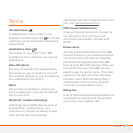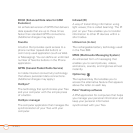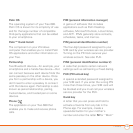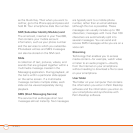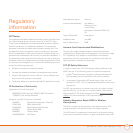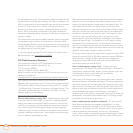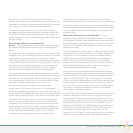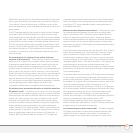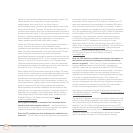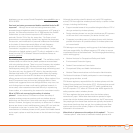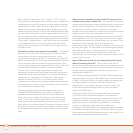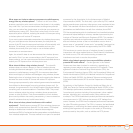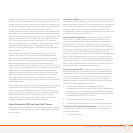
REGULATORY INFORMATION
250
human body absorbs RF energy most efficiently. For products that
only expose part of the body, such as wireless phones, exposure
limits in terms of SAR only are specified.
The exposure limits used by the FCC are expressed in terms of SAR,
electric and magnetic field strength, and power density for
transmitters operating at frequencies from 300 kHz to 100 GHz. The
specific values can be found in two FCC bulletins, OET Bulletins 56
and 65: http://www.fcc.gov/oet/info/documents/bulletins/#56;
http://www.fcc.gov/oet/info/documents/bulletins/#65.
Why has the FCC adopted guidelines for RF exposure? The FCC
authorizes and licenses products, transmitters, and facilities that
generate RF and microwave radiation. It has jurisdiction over all
transmitting services in the U.S. except those specifically operated by
the Federal Government. While the FCC does not have the expertise
to determine radiation exposure guidelines on its own, it does have
the expertise and authority to recognize and adopt technically sound
standards promulgated by other expert agencies and organizations,
and has done so. (Our joint efforts with the FDA in developing this
website is illustrative of the kind of inter-agency efforts and
consultation we engage in regarding this health and safety issue.)
Under the National Environmental Policy Act of 1969 (NEPA), the FCC
has certain responsibilities to consider whether its actions will
significantly affect the quality of the human environment. Therefore,
FCC approval and licensing of transmitters and facilities must be
evaluated for significant impact on the environment. Human
exposure to RF radiation emitted by FCC-regulated transmitters is
one of several factors that must be considered in such environmental
evaluations. In 1996, the FCC revised its guidelines for RF exposure
as a result of a multi-year proceeding and as required by the
Telecommunications Act of 1996.
Radio and television broadcast stations, satellite-earth stations,
experimental radio stations and certain wireless communication
facilities are required to undergo routine evaluation for RF compliance
when they submit an application to the FCC for construction or
modification of a transmitting facility or renewal of a license. Failure
to comply with the FCC's RF exposure guidelines could lead to the
preparation of a formal Environmental Assessment, possible
Environmental Impact Statement and eventual rejection of an
application. Technical guidelines for evaluating compliance with the
FCC.
RF safety requirements can be found in the FCC's OET Bulletin 65:
http://www.fcc.gov/oet/info/documents/bulletins/#65
.
Low-powered, intermittent, or inaccessible RF transmitters and
facilities are normally excluded from the requirement for routine
evaluation for RF exposure. These exclusions are based on standard
calculations and measurement data indicating that a transmitting
station or equipment operating under the conditions prescribed is
unlikely to cause exposures in excess of the guidelines under normal
conditions of use. Such exclusions are not exclusions from
compliance, but, rather, exclusions from routine evaluation. The
FCC's policies on RF exposure and categorical exclusion can be found
in Section 1.1307(b) of the FCC's Rules and Regulations [(47 CFR
1.1307(b)].
How can I obtain the Specific Absorption Rate (SAR) value for
my wireless phone? The FCC requires that wireless phones sold in
the United States demonstrate compliance with human exposure
limits adopted by the FCC in 1996. The relative amount of RF energy
absorbed in the head of a wireless telephone-user is given by the
Specific Absorption Rate (SAR), as explained above. The FCC requires
wireless phones to comply with a safety limit of 1.6 watts per
kilogram (1.6 W/kg) in terms of SAR.
Information on SAR for a specific phone model can be obtained for
many recently manufactured phones using the FCC identification (ID)
number for that model. The FCC ID number is usually printed
somewhere on the case of the phone. Sometimes it may be
necessary to remove the battery pack to find the number. Once you
have the ID number, go to the following Web address: www.fcc.gov/
oet/fccid. On this page, you will see instructions for entering the FCC
ID number. Type the FCC ID number exactly as requested (the
Grantee Code is the first three characters, the Equipment Product
Code is the rest of the FCC ID number). Then click on “Start Search.”
The “Grant of Equipment Authorization” for your telephone should
appear. Read through the grant for the section on “SAR Compliance,”
“Certification of Compliance with FCC Rules for RF Exposure” or
similar language. This section should contain the value(s) for typical or
maximum SAR for your phone.
Phones and other products authorized since June 2, 2000, should
have the maximum SAR levels noted directly on the “Grant of
Equipment Authorization.” For phones and products authorized
between about mid-1998 and June 2000, detailed information on




